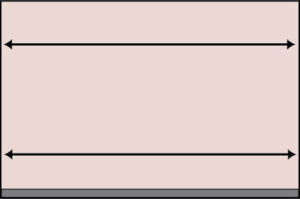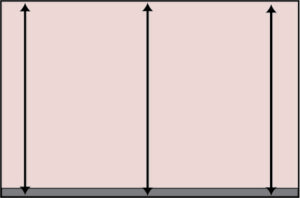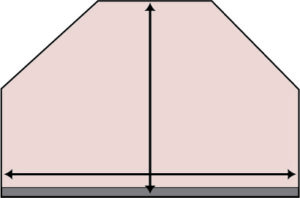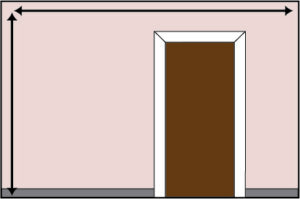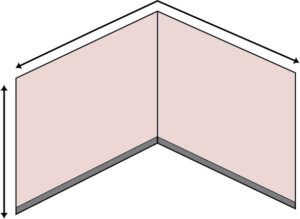When ordering your customised wallpaper, it is important that you enter the correct height and width when putting together your wallpaper. The height entered is the height of the wallpaper you will receive. We show you the width of the strips after you have entered the size of your wall. There are different situations in which you measure the wall. In this article we tell you how to measure your wall.
Straight walls
The easiest wall to measure is a straight wall. What is important when measuring a straight wall is that you do this at several points. A wall is not always straight, especially in older houses. We advise you to measure the wall in several places, both in width and height.
By measuring both the height and width in 2 places, you will know how much wallpaper you have. To do this, take the largest measurement in the width and the largest measurement in the length. This way, even if your wall is not straight, you will have enough wallpaper.
Measuring the width
Use a tape measure or tape measure to measure the width of the wall as shown in the example. Measure over any skirting boards so that you don’t run out of wallpaper later. It’s best to measure at the top and bottom of the wall. That way you can be sure to order enough wallpaper, even if the wall is not completely straight. The width of your wallpaper is the longest width of the wall.
Measuring the height
It is best to measure the height of the wall at 3 points; at the left, right and centre. This way, you avoid missing wallpaper in height when the wall is not completely straight. Always measure including any skirting boards. The extra wallpaper can easily be cut away with a knife when you have applied the wallpaper to the wall.
⚠️ Extra margin
Walls can always be uneven, especially in old houses. To prevent running short of wallpaper, we recommend adding 10cm in both height and width.
Sloping walls
When dealing with walls that come to a point or have a sloping angle, measure the wall at its widest and highest points. We print the wallpaper as a complete rectangle, and you will need to trim it to fit the corner yourself, which you can easily do using a cutting ruler and a knife. Because the exact angle can be challenging to determine in advance, this is the safest solution to ensure that you have enough wallpaper to neatly cover the wall.
Extra margin
Walls can always be uneven, especially in old houses. To prevent running short of wallpaper, we recommend adding 10cm in both height and width.
Walls with doors and windows
When you want to wallpaper a wall that has a door or window, you also measure the entire wall. When applying the wallpaper strips, use a knife to cut the wallpaper around the window or door.
This is how you determine where your window or door will be placed.
If you want to know exactly where your window will appear on your wallpaper, use the ruler on the product page by activating the ‘show ruler’ option. You can then place the red lines at the bottom of your cutout where the door or window is located. This way, you can see which part of the image will be hidden when applying the wallpaper. If an essential element of the wallpaper is obscured by a door or window, try mirroring the wallpaper. If that still doesn’t work, consider reaching out to our design team for assistance.
Multiple walls
If you want to apply wallpaper across multiple walls, there are various options available. If your wall only needs to go around the corner, you can opt for continuous wallpaper. Are the walls separated by a door or another partition? Our graphic team can ensure that your wallpaper seamlessly transitions.
Continuous walls
If your wall goes around the corner, you should measure both walls separately as if they were straight walls. Then, add the length of both walls together, and do the same for the height. This way, you will have the total length and height of your wall, and you’ll know which dimensions to order. Make sure to measure at various points so that you add the longest lengths (and heights) together.
Splitted walls
Is the wall interrupted by a door or a fireplace mantel, for example? In that case, you should order both walls separately. If you want a specific cutout and want the left and right parts to visually align, please contact our graphic team. They can arrange your wallpaper in a way that makes it appear as though the image continues across the entire wall.
Extra margin
Walls can always be uneven, especially in old houses. To prevent running short of wallpaper, we recommend adding 10cm in both height and width.
Hanging wallpaper in a stairwell
Hanging wallpaper in a stairwell is always a challenge. When measuring a stairwell, you should also select the highest and widest points. Just like with straight walls, measure these points at different spots to ensure you are measuring at the broadest and tallest points.
You order and receive your wallpaper as a rectangle. You will need to cut the slanted side yourself. This can be easily done using a cutting ruler and a sharp cutting knife.
Extra margin
Walls can always be uneven, especially in old houses. To prevent running short of wallpaper, we recommend adding 10cm in both height and width.

